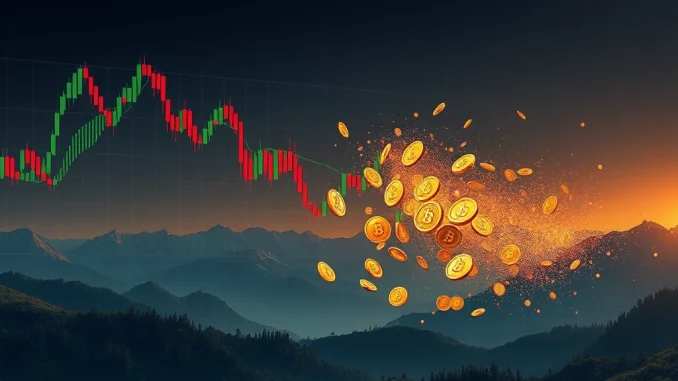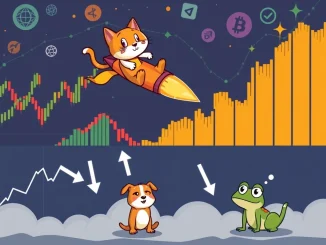
In the fast-paced world of digital assets, moments of intense volatility can strike without warning. Recently, cryptocurrency markets saw a dramatic event unfold, with over $102 million worth of futures positions liquidated in just one hour across major exchanges. This sudden shake-up follows a larger trend, with total liquidations exceeding $237 million in the past 24 hours. For anyone involved in or watching futures trading, this is a stark reminder of the inherent risks and the power of rapid price swings.
What is Crypto Liquidation, Anyway?
If you’re new to leveraged trading, the term ‘crypto liquidation‘ might sound complex, but the concept is straightforward. It’s the forced closure of a trader’s leveraged position by an exchange. This happens when a trader’s margin balance falls below the required maintenance margin level. Essentially, the market moved against their bet so significantly that they no longer have enough collateral to keep the position open, and the exchange automatically closes it to prevent further losses exceeding the initial margin.
Think of it like this: you borrow money (leverage) to place a larger bet on the price direction of a cryptocurrency. If the price goes your way, your profits are magnified. But if it moves against you, your losses are also magnified. If those losses eat up your initial stake and the borrowed funds reach a critical point, the exchange steps in and liquidates the position.
Understanding Crypto Leverage and Its Double Edge
Crypto leverage allows traders to control a large position with a relatively small amount of capital. For instance, with 10x leverage, you can open a $10,000 position with just $1,000 of your own money. This can be incredibly profitable if the market moves favorably, but it drastically increases the risk. A small price movement against your position can quickly wipe out your initial margin.
The higher the leverage used, the smaller the price movement required to trigger a liquidation. This is why sudden price drops or pumps can be particularly devastating for highly leveraged positions.
Why Did This Liquidation Cascade Happen?
The recent surge in liquidations, particularly the intense $102 million hour, is a direct consequence of increased market volatility. While the specific trigger can vary (macro news, whale activity, technical factors), a rapid price change in a major cryptocurrency likely initiated the event. When prices move sharply, positions that were just on the edge of being unprofitable suddenly cross the liquidation threshold.
This often leads to a liquidation cascade. As positions are liquidated, the exchange market-sells the underlying assets. This selling pressure can push prices down further, triggering *more* liquidations, which leads to more selling, and so on. This domino effect accelerates the price movement and racks up significant losses for traders caught on the wrong side.
Navigating Market Volatility in Futures Trading: Actionable Insights
Events like the recent $102 million liquidation highlight the critical importance of risk management in futures trading. Here are a few key takeaways:
- Manage Your Leverage: Avoid using excessively high leverage, especially during periods of anticipated volatility. Lower leverage means you can withstand larger price swings before facing liquidation.
- Use Stop-Loss Orders: Always place stop-loss orders to automatically close your position if the price reaches a certain unfavorable level. This limits your potential loss and prevents liquidation.
- Size Your Positions Wisely: Don’t allocate too much of your total capital to a single leveraged trade. Even with a stop-loss, a large position can result in a significant loss relative to your portfolio size.
- Understand Funding Rates: Be aware of funding rates on perpetual futures, which can add costs to holding positions, especially during volatile periods.
- Stay Informed: Keep track of market news and sentiment that could contribute to sudden price movements and increased market volatility.
The Impact Beyond Individual Traders
While individual traders bear the direct losses from crypto liquidation, large-scale events also impact the broader market. They can:
- Exacerbate price declines (due to the forced selling).
- Increase fear and uncertainty among market participants.
- Temporarily reduce open interest on exchanges as positions are closed.
These cascading events are a feature of highly leveraged markets and serve as a reset mechanism, albeit a painful one for many.
Conclusion: Prudence in a Volatile Landscape
The liquidation of over $102 million in just an hour serves as a powerful reminder of the risks inherent in futures trading, particularly when combined with high crypto leverage in a landscape prone to market volatility. Understanding what a liquidation cascade is and why it happens is crucial for traders. While leverage offers the potential for amplified gains, it equally amplifies potential losses, leading to events like the significant crypto liquidation seen recently. Success in this environment isn’t just about predicting price movements, but fundamentally about rigorous risk management and respecting the power of the market.



